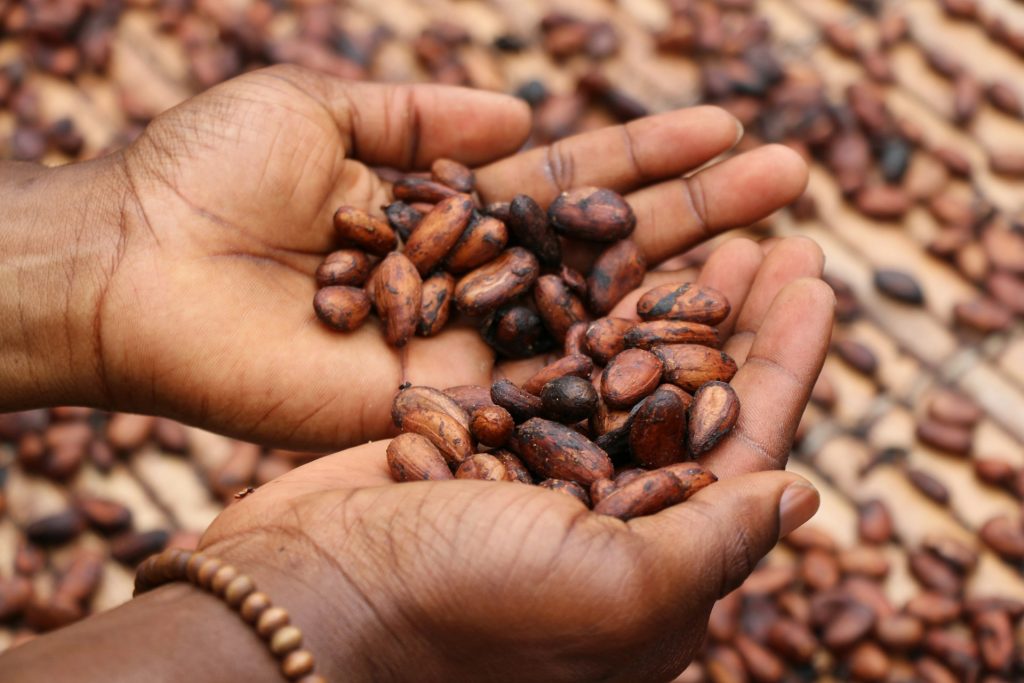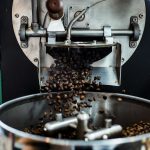Table of Contents
Coffee beans and cocoa beans, though often thought of as cousins with overlapping growth regions in South America and similar stimulant effects, have distinctive qualities that set them apart. Both beans boast rich flavor profiles, with coffee having over a thousand aromatic compounds and cocoa beans featuring over six hundred. The coffee fruit yields coffee beans that are the seeds nestled inside bright red berries, while cocoa powder is derived from the fat content of cocoa beans. These beans not only provide unique sensory experiences but also carry health implications, from potential benefits for heart disease and type 2 diabetes to reduced risks of Parkinson’s disease and liver cancer when consumed in moderation.
Tracing the Origins of Our Favorite Beans
The history of our beloved chocolate and coffee begins with ancient civilizations in South America, where both plants were cultivated for their rich aroma and flavor profiles.
The Birth of the Coffee Bean
Legend has it that an Ethiopian goat herder first discovered coffee beans’ potential after noticing the bright red berries’ energizing effect on his flock. From there, coffee plants spread across the globe, developing into the coffee drinker’s essential. Each coffee bean starts its journey inside the coffee fruit, eventually becoming a cup of brewed coffee that millions enjoy daily.
The story of coffee is one of adventure and transformation, from the ancient coffee forests of Ethiopia to today’s vast plantations across various continents.
Cocoa Beans: From Ancient Rituals to Modern Delight
Unlike coffee, cocoa beans were once integral to ancient rituals and ceremonies, symbolizing wealth and luxury. The journey of cocoa beans into modern delight began with indigenous South American cultures, where they were consumed and used as currency.
Today, from cocoa powder to chocolate bars, these beans, with their natural fat content and rich cacao content, continue to captivate taste buds around the world.

The Journey from Farm to Cup and Bar
From the lush landscapes where they’re grown to the final products we savor, coffee beans and cocoa undergo transformative journeys, each requiring meticulous care and attention.
Cultivating and Harvesting Coffee Beans
Cultivating coffee beans begins with selecting the perfect location, often in high-altitude regions, where coffee plants flourish under specific climatic conditions.
Picking the Perfect Cherry
The perfect cup of coffee starts with picking the ripest coffee cherries. Each cherry is carefully selected and harvested by hand, ensuring only the best quality beans continue through the processing method. This delicate task is crucial to the coffee’s final flavor.
Once harvested, the coffee cherries are sorted, and the coffee beans are extracted, ready for the next stage of their transformative journey.
The Multistep Coffee Processing Method
After harvesting, green coffee beans, which are actually the seeds of the coffee plant, undergo a multistep processing method. This includes drying, fermenting, and hulling, preparing them for the pivotal stage of roasting coffee, where flavors are developed and enhanced.
The roasting process is an art form, turning the green coffee beans into aromatic brown beans that are ready to be ground and brewed.
The Cocoa Bean Lifecycle
The lifecycle of a cocoa bean is equally intricate, beginning with its own unique cultivation and harvest rituals.
Harvesting the Cacao Pods
Cacao pods from the tree are harvested by hand, a labor-intensive process that is crucial for obtaining the highest quality cacao beans. These vibrant pods contain the precious seeds that will eventually become chocolate liquor.
After harvesting, the cacao pod is opened, and the cacao beans are collected. The beans are fermented to develop their characteristic chocolate flavor and to reduce moisture content.
The Intricate Process of Cocoa Bean Fermentation and Drying
The fermentation of cocoa beans is a critical step that involves carefully controlled conditions to allow the development of the beans’ rich flavor. This process is followed by drying, stabilizing the beans and preparing them to become chocolate.
After fermentation and drying, the beans are roasted, ground, and refined into the chocolate products we enjoy, each with varying cacao content based on the desired end product.
The Chemical Composition of Coffee and Cocoa
The complexity of coffee and cocoa is not just in their rich histories and processing but also in their chemical makeup, which we’ll explore next.
Caffeine Content: A Stimulating Debate
The caffeine content in coffee varies depending on the brewing method, with a cup of brewed coffee containing between 80 and 135 mg of caffeine. This stimulant is renowned for its ability to increase alertness and energy levels, making coffee a favorite for many seeking a morning or midday boost.
While coffee increases physiological activity, the debate around caffeine consumption continues, balancing the benefits of alertness against potential overstimulation.
Antioxidants in Coffee and Cocoa Beans
Coffee and cocoa beans are a rich source of antioxidants, compounds that significantly protect the body from oxidative stress and inflammation. These antioxidants contribute to the health benefits associated with moderate consumption of coffee and cocoa products.
Understanding the antioxidants in coffee and cocoa beans opens up a world of health potential, from their protective properties to their role in chronic disease prevention.
Flavanols and Flavonols: The Heart of Cocoa’s Benefits
Cocoa beans boast a rich supply of flavanols, a group of antioxidants known for their vibrant contribution to plant colors and human health benefits. Unlike flavonols that attach to sugar molecules and primarily protect plants from sun damage, flavanols found in cocoa, as well as in other foods like wine and berries, play a crucial role in the nutritional value of cocoa products. These powerful antioxidants are associated with various health advantages, including improved blood flow and heart health.
While cocoa does not contain flavonols, the flavanols it does provide are central to its health benefits. Research suggests that these substances can help maintain a healthy heart and support cognitive function, making the consumption of cocoa more than just a sensory pleasure. The presence of flavanols in cocoa beans underscores their importance in a balanced diet and adds to the allure of cocoa-based indulgences.
The Roasting Renaissance
The roasting of cacao and coffee beans marks a transformative phase where their distinct flavors are fully developed. Through the application of heat, the roasting process amplifies the unique taste profiles of each bean, setting the stage for the beloved beverages of coffee and chocolate.
Coffee Roasting: An Art and Science
Roasting coffee is a delicate balance of art and science, where green coffee beans transition into aromatic treasures. The seeds of the coffee plant undergo a metamorphosis at high temperatures, often exceeding 200°C (400°F), where their sugars caramelize and flavors intensify. As the beans expand, they reach critical points known as the first and second “cracks,” signaling key stages in the development of their complex flavor profiles.
The art of roasting demands precision as the beans can evolve rapidly within seconds, requiring a vigilant eye to preserve the next harvest’s potential. Coffee producers around the world have honed this craft over centuries, with techniques gradually spreading since the 17th and 18th centuries, making coffee roasting an integral part of the journey from ripe coffee cherries to the billion cups enjoyed daily.
Cocoa Roasting: Unlocking Flavors
Cocoa roasting is essential in revealing the full flavor potential of cacao beans. The process is more than just the development of taste; it is a crucial step in eliminating unwanted acids and enhancing the beans’ natural flavors. Unlike coffee, which is roasted at higher temperatures, cacao beans undergo a gentler roasting process, which is tailored to their unique composition and the desire to preserve delicate flavor nuances.
During roasting, cacao beans shed their raw bitterness and reveal the rich, complex flavors synonymous with chocolate. This stage is vital in transforming the seeds from the cocoa pod to the indulgent chocolate products enjoyed worldwide. The skillful roasting of cacao beans is a testament to the art of chocolate making and the careful crafting required to unlock the full sensory experience of cocoa.
Health Impacts and Nutritional Benefits
Exploring coffee and cocoa’s health impacts and nutritional benefits reveals a tapestry of advantages and concerns. These beloved beans offer more than just taste; they contribute to our overall well-being.
Coffee: Friend or Foe to Your Health?
Coffee, a beverage derived from the roasted seeds of the coffee plant, has a storied relationship with health. Regular coffee consumption has been linked to various benefits, including enhanced cognitive function and potential protection against certain diseases. However, the caffeine jitters associated with overconsumption can pose a downside, making moderation key.
The debate continues as research delves deeper into the effects of coffee on heart health and other aspects of our well-being. While stories of coffee’s health benefits circulate, so do concerns about its impact when consumed in excess. As a staple in many diets, coffee’s role as either a friend or foe to health remains a topic of ongoing investigation and discussion.
The Sweet Truth About Cocoa’s Health Benefits
Cocoa consumption has long been associated with pleasure, but recent studies shed light on its health benefits as well. Rich in flavanols, cocoa supports heart health and may even contribute to improved mood and cognitive function. Unlike the caffeine jitters that can accompany coffee, the theobromine in cocoa provides a gentler stimulation, making it a favorable option for those sensitive to caffeine.
As the stories of coffee and its health impacts circulate, cocoa stands out with its sweet truth. The health benefits of cocoa extend beyond the enjoyment of chocolate, offering a guilt-free reason to indulge in its rich flavors. With research continuing to explore these benefits, cocoa remains a delightful addition to a health-conscious diet.
Cultural Significance and Consumption Patterns
The cultural significance of coffee and cocoa is as rich and varied as their flavors. Both have profoundly influenced social customs, traditions, and daily life across the globe.
Coffee as a Global Phenomenon
Coffee has become a global phenomenon, transcending its origins to become a centerpiece of social interactions and daily routines. From the high-altitude regions where coffee cherries flourish, the beans have traveled far and wide, ingraining themselves in cultures around the world. Arabica, Robusta, Liberica, and Excelsa varieties each carry distinct flavors and stories that coffee aficionados cherish.
The ritual of hand-picking ripe coffee cherries and the labor-intensive process of preparing the beans for roasting has been refined over time. As coffee continues to captivate taste buds and stimulate conversations, its role as a social lubricant and symbol of hospitality remains unmatched, solidifying its status as a beloved beverage worldwide.
Cocoa’s Cultural Journey from Luxury to Everyday Indulgence
Once a luxury reserved for the elite and used in ancient rituals, cocoa has made a cultural journey to become an everyday indulgence. Revered by Mesoamerican civilizations and considered a divine elixir, cocoa consumption has evolved to be a staple in modern life. The transformation from a sacred commodity to a widely enjoyed treat reflects the democratization of cocoa’s delights.
Today, cocoa continues to enrich cultural traditions and satisfy global cravings. Its versatility in confectionery and baking, combined with its storied past, ensures that cocoa remains an integral part of human culture. As it moves from luxury to commonplace, cocoa maintains its allure, continuing to be a source of comfort and celebration.

The Future of Coffee and Cocoa Consumption
As global demand grows, the future of coffee and cocoa consumption looks toward sustainability and innovation to meet the challenges and preferences of consumers worldwide.
Sustainability Efforts in Coffee and Cocoa Production
Sustainability efforts are becoming increasingly vital in coffee and cocoa production as stakeholders aim to ensure the longevity of these beloved beans. A cup of freshly brewed coffee or a square of dark chocolate not only brings joy but also carries the responsibility of environmental and social stewardship. Producers, consumers, and industry leaders are collaborating to create a more sustainable future for both industries.
From preserving seeds from the cocoa pod to implementing eco-friendly farming practices, the focus is on minimizing the environmental impact while maintaining the quality and availability of coffee and cocoa. These collective efforts are crucial in addressing climate change, safeguarding biodiversity, and supporting the livelihoods of farmers who cultivate these precious crops.
Innovations in Bean Processing and Flavor Enhancement
Innovations in bean processing are revolutionizing the way we experience coffee and cocoa. Advances in technology and methodology are enhancing the natural flavors of beans, providing an even richer tasting experience. From precision fermentation techniques to novel roasting profiles, the industry is constantly seeking ways to improve the final product.
These innovations extend beyond flavor enhancement; they also aim to improve the efficiency and sustainability of the production process. As the beans are seeds from the cocoa pod and coffee cherry, their journey from farm to cup or bar is being reimagined through innovation, ensuring that future generations can continue savor these cherished beans’ unique tastes.
Savoring the Taste: An Exploration of Flavors
The exploration of flavors in coffee and cocoa beans offers a sensory journey like no other. Each bean carries a distinct profile waiting to be discovered and savored.
The Unique Taste Profiles of Coffee Beans
The unique taste profiles of coffee beans are as varied as their origins. With over 1000 aromatic compounds, coffee offers a complex spectrum of flavors that can range from fruity and floral to rich and earthy. The journey of coffee beans from the berry fruit of the coffee plant to the final brew is marked by meticulous cultivation, harvesting, and roasting processes that preserve their distinct characteristics.
As coffee producers refine their techniques, consumers around the world delight in the nuances of each variety. Eating the berries of the coffee plant may not be as pleasant as savoring a brewed cup, but the transformation of the beans unlocks a world of flavors. As coffee gradually spread from its native lands, it has become a globally recognized and celebrated beverage, intricately woven into the fabric of many cultures.
The Richness of Cocoa: Beyond Just Chocolate
The journey of cocoa beans extends far beyond their celebrated end in chocolate bars. After the drying process, where the cocoa beans are dried, cocoa butter is meticulously extracted, leaving behind the essence for cocoa powder. This remaining substance is then compressed into cakes, which are further pulverized into the fine cocoa powder cherished in kitchens worldwide. The versatility of cocoa manifests in a variety of culinary applications, from the richness of mole sauce to the subtle notes in dustings over confections and desserts.
Cocoa farmers cultivate millions of tons of cocoa worldwide, with each bean harboring the potential for diverse pairings and flavor profiles. Beans are typically selected for specific characteristics, influencing the final taste of the cocoa products they become. While a vast portion of harvested beans find their way into the production of chocolate, inventive chefs and food enthusiasts continue to explore the full spectrum of cocoa’s gastronomic potential, pairing its rich and complex flavors with spices, fruits, and even meats to create novel and unexpected delights.
Wrapping Up the Great Bean Debate
As we conclude the exploration of coffee and cocoa beans, it’s clear that both hold a treasured place in our lives, offering not just unique flavors but also rich cultural significance. Despite their differences, including the stimulating effects of caffeine in coffee and theobromine in cocoa, they share surprising similarities. From their complex flavor profiles—with coffee boasting over a thousand aromatic compounds and cocoa over six hundred—to their shared origins in equatorial regions, these beans are indeed akin to distant cousins in the plant kingdom. Moreover, the consumption of coffee, whether it’s the morning ritual of drinking coffee or the choice of decaffeinated coffee, parallels the indulgence in chocolate, highlighting the diverse ways these beans enhance our daily lives.

I’m Audrey, a dedicated mother of teenagers with an insatiable love for coffee. On BeanBrewLove.com, I intertwine my need for caffeine with reflections on life. Whether expressing a nostalgic sentiment or injecting a hint of sarcasm, my blog is a reservoir of coffee culture, brewing techniques, and global coffee reviews.




